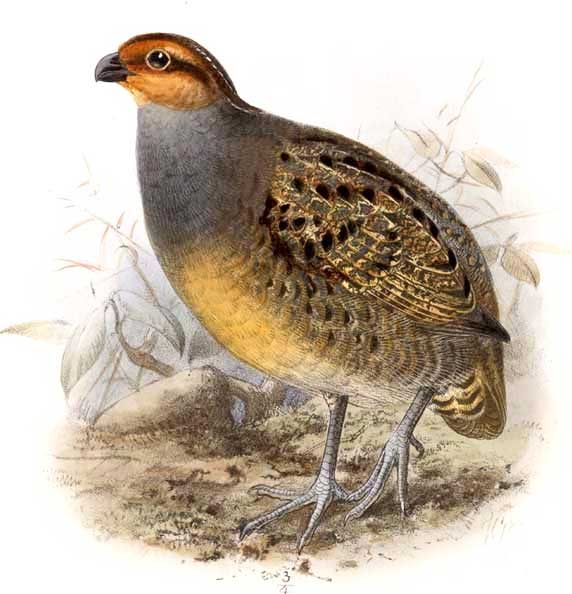
Rhynchortyx cinctus
Superregnum: Eukaryota
Cladus: Unikonta
Cladus: Opisthokonta
Cladus: Holozoa
Regnum: Animalia
Subregnum: Eumetazoa
Cladus: Bilateria
Cladus: Nephrozoa
Superphylum: Deuterostomia
Phylum: Chordata
Subphylum: Vertebrata
Infraphylum: Gnathostomata
Megaclassis: Osteichthyes
Cladus: Sarcopterygii
Cladus: Rhipidistia
Cladus: Tetrapodomorpha
Cladus: Eotetrapodiformes
Cladus: Elpistostegalia
Superclassis: Tetrapoda
Cladus: Reptiliomorpha
Cladus: Amniota
Classis: Reptilia
Cladus: Eureptilia
Cladus: Romeriida
Subclassis: Diapsida
Cladus: Sauria
Infraclassis: Archosauromorpha
Cladus: Crurotarsi
Divisio: Archosauria
Cladus: Avemetatarsalia
Cladus: Ornithodira
Subtaxon: Dinosauromorpha
Cladus: Dinosauriformes
Cladus: Dracohors
Cladus: Dinosauria
Ordo: Saurischia
Cladus: Eusaurischia
Subordo: Theropoda
Cladus: Neotheropoda
Cladus: Averostra
Cladus: Tetanurae
Cladus: Avetheropoda
Cladus: Coelurosauria
Cladus: Tyrannoraptora
Cladus: Maniraptoromorpha
Cladus: Maniraptoriformes
Cladus: Maniraptora
Cladus: Pennaraptora
Cladus: Paraves
Cladus: Eumaniraptora
Cladus: Avialae
Infraclassis: Aves
Cladus: Euavialae
Cladus: Avebrevicauda
Cladus: Pygostylia
Cladus: Ornithothoraces
Cladus: Ornithuromorpha
Cladus: Carinatae
Parvclassis: Neornithes
Cohors: Neognathae
Cladus: Pangalloanserae
Cladus: Galloanseres
Ordo: Galliformes
Familia: Odontophoridae
Genus: Rhynchortyx
Species: Rhynchortyx cinctus
Subspecies: R. c. australis - R. c. cinctus - R. c. hypopius - R. c. pudiobundus
Name
Rhynchortyx cinctus (Salvin, 1876)
References
Ibis p. 379
Vernacular names
English: Tawny-faced Quail
svenska: Orangekindad vaktel
The tawny-faced quail (Rhynchortyx cinctus) is a species of bird in the family Odontophoridae, the New World quail. It is found in Colombia, Costa Rica, Ecuador, Honduras, Nicaragua, and Panama.[2]
Taxonomy and systematics
The tawny-faced quail is the only member of genus Rhynchortyx. It has three subspecies, the nominate R. c. cinctus, R. c. pudibundus, and R. c. australis.[2]
Description
The tawny-faced quail is 17 to 20 cm (6.7 to 7.9 in) long. A male weighed 165 g (5.8 oz) and an unsexed individual 150 g (5.3 oz). The adult male of the nominate subspecies has a reddish face with a black streak through the eye. Its crown and hindneck are dark brown; the back and rump are gray to brown with black streaks. Its throat and upper breast are gray while the rest of the undersides are tawny buff with some white between the legs. The nominate adult female has a similar pattern but is generally browner. Its crown and back are dark brown and the rump mottled brown and chestnut. The face and upper breast are reddish brown and the eyeline, chin, and throat white. The lower breast and belly are pale with black barring. R. c. pudibundus is paler overall and R. c. australis darker.[3]
Distribution and habitat
The tawny-faced quail has a discontinuous range. The nominate subspecies is found in Costa Rica and Panama. R. c. pudibundus is found in northeastern Honduras and eastern Nicaragua. R. c. australis is found on the Pacific coasts of Colombia and far northern Ecuador. The species inhabits lowland tropical forest up to about 1,450 m (4,760 ft) of elevation. It is primarily terrestrial but roosts in trees and bushes near the ground.[3]
Behavior
Feeding
The tawny-faced quail forages by pecking. Its diet has been recorded to include seeds, worms, and insects.[3]
Breeding
The tawny-faced quail's breeding season includes March and April in Panama but has not been documented elsewhere. Little other information about its breeding phenology has been published.[3]
Vocalization
Dickcissel male perched on a metal pole singing, with neck stretched and beak open.
Songs and calls
Listen to tawny-faced quail on xeno-canto
The tawny-faced quail's song is "a series of pure monotonous whistles followed by a series of whistles at a lower and/or higher pitch" and has been likened to that those of tinamous or doves. The species is often vocal at dusk but also sings while roosting at night. Members of a covey keep in contact with soft peeping calls.[3]
Status
The IUCN has assessed the tawny-faced quail as being near threatened.[1] It is rather rare in much of its range, and "[m]ajor threats possibly include deforestation and hunting."[3]
References
BirdLife International (2022). "Tawny-faced Quail Rhynchortyx cinctus". IUCN Red List of Threatened Species. 2022. Retrieved 27 July 2022.
Gill, F.; Donsker, D.; Rasmussen, P. (July 2021). "IOC World Bird List (v 11.2)". Retrieved July 14, 2021.
Carroll, J. P., G. M. Kirwan, and P. F. D. Boesman (2020). Tawny-faced Quail (Rhynchortyx cinctus), version 1.0. In Birds of the World (J. del Hoyo, A. Elliott, J. Sargatal, D. A. Christie, and E. de Juana, Editors). Cornell Lab of Ornithology, Ithaca, NY, USA. https://doi.org/10.2173/bow.tafqua1.01 retrieved September 10, 2021
Retrieved from "http://en.wikipedia.org/"
All text is available under the terms of the GNU Free Documentation License

